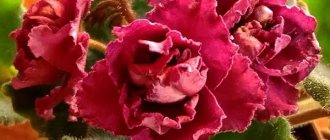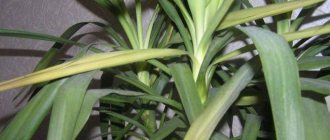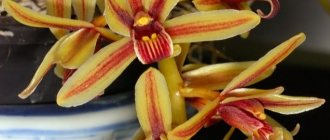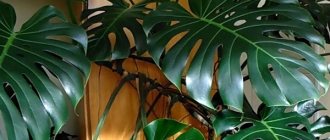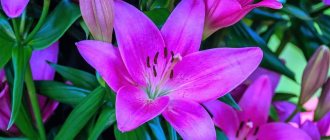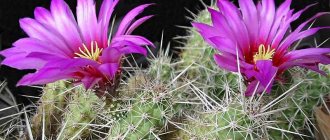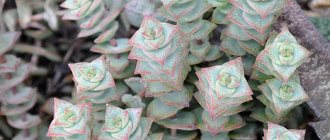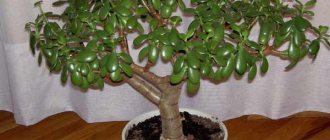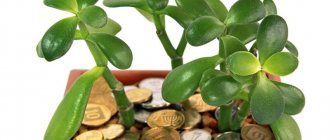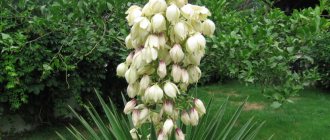Increasingly, in the “diet” of amateur gardeners one can find exotic plants that have occupied a dense niche among the usual flowers. Today we will talk about yucca, a representative of the agave family, brought to us from North and Central America. There are hardly any flower lovers who do not have this “piece” of exoticism in their greenhouses. Such a wonderful plant can easily grow at home.
Name of varieties, description and photos of varieties
This rather unpretentious beauty has about 40 species. The most common varieties have settled in our apartments.
Evergreen yucca has lanceolate long leaves, the length of which varies depending on the plant variety. The length of the tree-like stem also depends on the type of yucca. Often the trunk is almost invisible, due to the fact that the leaves are located very low.
The most common types:
False elephant
This variety is also called Yucca Elefantis. The plant received this name because its trunk is very similar in structure to an elephant’s leg. At home, false yucca grows in open ground. However, due to our climatic conditions, flower growers recommend this plant as an indoor flower.
At a young age, elephant yucca is represented by bushy development. An adult plant has a thick trunk covered with rough bark. As the lower leaves of the plant dry out (a natural process), the trunk becomes increasingly exposed and increases in size.
The dark green surface of the lance-shaped leaves reaches a length of more than a meter and has needle-like edges.
Yucca Elefanto is characterized by summer flowering, which ends in autumn. White large flowers are collected in inflorescences. Subsequently, they form juicy fruits, the size of which is about 2 cm.
You can watch a review of elephant yucca in this video:
Sadovaya
Despite the fact that yucca came to us from warm countries, it has acclimatized remarkably well in our open areas. This tree-like shrub has long, stiff leaves that grow in a spiral pattern. In season, a long peduncle is formed from a dense rosette, on which there are up to 200 white bells.
Quite unpretentious to moisture and frost, in severe frosts it still needs to be covered. According to gardeners, although the flowering of garden yucca (filamentous) in open ground lasts only 2-3 weeks, the aroma of the flowers has a sweetish exotic smell.
You can watch a review of garden yucca (filamentous) in this video:
Gray
This is one of the most frost-resistant varieties that can withstand cold Russian winters. Gray yucca does not tolerate very waterlogged soil , much less stagnant water. In the garden, it should be planted in a sunny place so that it can fully open up and show its best qualities.
The plant is distinguished by its original gray-green color. The trunk of the gray yucca is almost invisible, since a dense rosette of narrow long leaves starts from the bottom.
In central Russia, it is better to cover such plants with special material for the winter to avoid freezing of the central bud. If the yucca is not covered, then during the winter it can shed leaves, the restoration of which will require a long summer period.
Aloe leaf
Aloe yucca is the most common indoor plant in the agave family. Unlike the gray yucca, this species is quite heat-loving and prefers to move outside exclusively in the summer.
At home, aloe yucca can reach 2 meters in height, however, such growth is observed in rare individuals. This plant has a dense woody stem, the top of which is crowned with a dense rosette of narrow long leaves.
If you have placed this beauty at home, then you need to take care of a large, bright room for her. Yucca loves spacious rooms with good access to fresh air. It should not be placed under scorching sunlight. Give it diffused light and it will delight you with its flowering.
Filamentosis
Yucca filamentosa, also known as filamentosa, gets its name from the thread-like processes along the edges of its narrow leaves.
This is one of the hardiest shrubs that looks exotic both in single plantings and in group plantings.
Yucca filamentosa has basal growth of leaves that reach a length of up to 90 cm. The flower stalks of filamentosa reach a length of about 1 meter.
This type of yucca is undemanding to soil quality and tolerates planting well. In open plantings, thanks to its multiple shoots, it can grow into huge ornamental bushes. In harsh winter conditions, it is better to cover the yucca by tying the bushes together. Later, this practice slowed down due to the lack of such a number of yucca plantations. However, the highest quality jeans still have some yucca cotton.
Shortleaf
This original type of yucca in natural conditions can reach a height of up to 9 meters. Due to its gigantic size, this plant is difficult to place at home .
The short, densely arranged leaves give yucca its originality. Expanded at the base, they resemble a triangle in shape. The crown is usually brownish in color with a lighter shade closer to the edge.
Due to its short vegetation, the flower stalks of short-leaved yucca are also miniature in size with pale yellow flowers.
More photos of yucca
Exotic Thailand. Part 6. False palm trees of Thailand
In the previous article in the series about traveling through exotic Thailand, we got acquainted with the variety of palm trees, which are considered a symbol of tropical countries. But many of our fellow countrymen are still confused about names and types, mistaking completely different plants for palm trees, which only resemble them in appearance. More than once we have had to deal with a situation where any plant with a trunk crowned with a fountain of large leaves is called a palm tree. To avoid disputes and misunderstandings, today we will talk about a group of plants that are conventionally grouped into the “false palm” group.
Madagascar ravenala or traveler's tree (Ravenala madagascariensis)
Many people know the appearance of this wonderful plant from films, since it is impossible not to notice it even among the tropical forest! A luxurious fan of 20-30 huge dark green leaves (length up to 3 m, width up to 50 cm) rises on a strong trunk reaching 15-25 m in height. Surprisingly, this tree is not a palm tree at all, but a relative of Strelitzia. Ravenalla got its name “traveler’s tree” thanks to the water that accumulated in the axils of the leaf petioles, which travelers could get and escape from the heat.
Madagascar ravenala or traveler's tree (Ravenala madagascariensis)
Madagascar, Reunion and Mauritius are considered the homeland of the ravenala, where its huge leaves are used as roofing material, and leaf veins are used as building material. Young leaves and seeds with a high starch content are eaten. The creamy white flowers are pollinated by birds and lemurs. Ravenala is used in landscaping in almost all warm countries; it is not for nothing that it is considered one of the most beautiful trees in the world.
Madagascar ravenala near Wat Chalong
Yucca
Flower growers in our country are familiar with numerous types of tropical yucca both in indoor floriculture and in open ground (yucca filamentosa). However, even today, even on gardening websites, yucca continues to be called an “indoor palm.” America is considered the homeland of 20 species of yucca, where fibers from the leaves and stems are used to make durable fabrics and ropes. In the tropical countries of Southeast Asia and Thailand you can find elephant yucca (Y. elephantipes), which, due to its exceptional unpretentiousness and heat resistance, is grown both in pots and in flower beds, where multi-stemmed plants can reach 9-10 m in height. The species got its name from the thickening at the bottom of the gray trunk, reminiscent of an elephant’s leg.
Yucca elephantipes
In the flowerbeds in front of the hotel there is an impressive group of Yucca aloifolia (Y. aloifolia), which grows well even on sand, thanks to which it has become a favorite plant for landscaping beaches and has even gone wild in nature from Florida to Spain, Portugal, Italy, Pakistan, South Africa and South Africa. -East Asia.
Yucca aloifolia in the landscaping of Phuket
Pandan, pandanus or screw palm (Pandanus)
In the tropical regions of the eastern hemisphere, scientists count about 750 species of pandanus, most of them representing multi-stemmed trees up to 10-15 m in height, sometimes up to 25 m. Pandanas can often be seen on the sea coast, on almost bare rocky rocks, where they are fixed thanks to numerous adventitious or stilted roots. The leaves are long, sword-shaped, covered with small spines along the edges and often along the upper side. Pandanus has long been cultivated in Ukraine in indoor culture; it is especially loved for its luxurious appearance and absolute unpretentiousness; it often decorates the halls of hospitals and institutions.
Pandanus or screw palm (Pandanus)
The aromatic pandan (P. tectorius), common in Thailand, produces orange fruits after flowering, which are mistaken for pineapples. The fruits of some pandan species (for example, the Polynesian P. tectorius) are suitable for human and animal food; the veins of the leaves are used as weaving material. Almost all parts of the plant are used in folk medicine, as well as in local witchcraft rituals.
Pandanus fruit is often confused with pineapple.
Pandanus sprouts on the beach
Banana (Musa)
For most of our fellow countrymen, banana (Thai. Kluai) is, first of all, a delicious fruit (we will talk more about Thai fruit trees later). Gardeners are familiar with the plant and its decorative forms. But most still do not know that a banana is not a tree or palm tree at all , and a herbaceous perennial. The genus banana (Musa) includes over 40 species distributed in tropical South Asia, the islands of the Malay Archipelago, New Guinea, North-Eastern Australia and the Pacific Islands. Some scientists believe that it is from the Southeast The Asian banana came to Africa, South and Central America.
Bananas in Phuket can be found at every turn
Bananas are large (with rare exceptions) perennial herbs with powerful underground rhizomes and shortened tuberous stems that almost do not protrude above the ground and bear spirally arranged huge leaves with unusually long sheaths, forming a dense multilayer tube of a false stem. Plants often reach a height of 5-6 m, and the huge banana (M. ingens) from New Guinea reaches up to 15 m in height and leaves 5-6 m, 0.6-1 m wide. There are also dwarfs in the genus, such as the rough-fruited banana (M. lasiocarpa) from the mountainous regions of Yunnan province in China, no higher than 60 cm with leaves up to 30 cm long. One of the features of bananas is its amazingly fast growth.
Wild banana thickets often become impenetrable hedges
From the beginning of growth to the moment of flowering and fruiting, the plant reaches 7-8 m in 8-10 months. After a few weeks, a large apical inflorescence appears at the top between the leaves. After flowering and fruiting, the entire aboveground part dies off. At the base of the false stem, lateral underground shoots are formed, which later give rise to new false stems with leaves. The flowers emit a specific smell that attracts bats. In the absence of natural pollinators, bananas do not bear fruit (with the rare exception of self-pollinating species) or sometimes form seedless parthenocarpic fruits.
Wild banana fruits with large seeds
In nature, bats, numerous birds, monkeys and tupayas feed on banana fruits. The banana fruit is a berry with a leathery shell and juicy pulp, in which numerous seeds are immersed.
Dracaena
Ukrainian flower growers are well acquainted with numerous species (more than 100-150 in tropical and subtropical areas) and a huge number of decorative varieties of “false palm” (dracaena), but not many are lucky enough to see dracaenas in their natural habitat. The name dracaena translates as “female dragon” and describes the orange or red color when cut through the trunk (“dragon’s blood”). The stems of dracaena are often woody, numerous, the leaves are sword-shaped and collected in apical bunches; in some species, the leaves grow along the entire stem. In indoor culture, dracaenas do not grow higher than 1.5-2 m, but in Thailand you can find many species of this wonderful multi-stemmed plant from 6 m - the Madagascar species Dracaena reflexa (D. reflexa) to 15 m, like the African fragrant dracaena (D. fragrans)
Among Dracaena reflexa (D. Reflexa var. angustifolia), the most popular varieties are those with red and pale yellow stripes on the leaves, the most popular of which in the world are “Song of Jamaica” and “Song of India”. Dracaena 'Song of India' has numerous woody, graceful trunks covered from bottom to top with narrow, downward-curved leaves with expressive yellow or white double stripes along the edge.
Dracaena reflexum 'Song of India'
The variety "Song of Jamaica" is characterized by leaves with a dark green stripe in the middle and a white border along the edges.
Dracaena reflexa 'Song of Jamaica'
In Thailand, they love red in all forms, so Dracaena D. marginata, a natural species with green leaves and a reddish-purple stripe along the edge, and its varieties are popular here. They are most often planted near Buddhist altars and in front gardens.
Dracaena marginata
Cordyline
Cordylines are often mistaken for palms and confused with dracaenas, which are their closest relatives and are part of the Asparagus family. Among the cordylines, found in the warm countries of Asia, Australia and America, one can find trees, shrubs and subshrubs that form shoots. The starchy rhizomes have a sweet taste and are used as food or medicine. The beautiful sword-shaped leaves are sessile, and in popular varieties they are often colored in purple, coral and pink tones.
Cordyline fruticosa in container culture
In indoor floriculture there is the Australian southern cordyline (Cordyline australis), but the most popular, also growing in Thailand and the countries of Southeast Asia, is the bush cordyline (Cordyline fruticosa). This species grows up to 4 m in height, and the leaves can reach 60 cm in length and 10 cm in width. Among the Hawaiians, cordyline is considered a sacred plant and has the ability to ward off evil spirits.
Cordyline near Jim Thompson's house
Cycad or Cycas (Cycas)
The cycad or cycas has the appearance of a classic palm tree with pinnate or double-pinnate leaves arranged in the form of a crown at the top of a strong trunk covered with the remains of dead leaves. However, surprisingly, botanists classify cycads as gymnosperms, which means their closest relatives are not palm trees, but conifers. This amazing plant is called a “living fossil” and is considered the same age as dinosaurs, because its fossils date back to 280 million years.
Cycas or Cycas
Scientists have found about 90 species of Cycas in tropical areas, for example, the most popular Cycas revoluta from southern Japan, curled or snail-shaped Cycas (C.circinalis), found in Australia, Sri Lanka, Taiwan and the Philippines, comb-shaped Cycas (C. pectinata) and c. Siamese from India and Vietnam. In its homeland, the cycas grows into a powerful tree 7-8 m high (the Rumpha cycas is up to 15 m) with a trunk diameter of more than a meter and lives up to 200 years. In indoor culture it grows very slowly, forming one rosette of leaves per year. It is found in the landscaping of European countries, for example, in Spain and Italy.
Photos taken by the author in Thailand in December 2022
Victoria Roy landscape designer specifically for the gardening online portal
Features of care and cultivation
Although yucca is an overseas plant, it is not capricious and not picky in matters of care. Growing mainly requires moderate moisture, properly selected lighting and shelter for the winter if the yucca grows in an open area.
At home, the main requirement for yucca is dosed watering of the plant. It should be done if the top layer of the plant is dry. If water accumulates in the pan, it should be drained to avoid rotting of the root system.
Yucca welcomes spraying with water at room temperature. During winter, this procedure is not necessary. Simply wipe the leaves of the plant with a damp sponge.
Although yucca came to us from a hot climate, it does not tolerate direct sunlight. However, it must be placed on the sunny side, shaded from the sun.
In winter, it is necessary to extend the daylight hours for yucca. This can be done using artificial light sources.
Some types of plants (thread-like yucca) feel great in open areas. For growing in open ground, you need to comply with the same requirements as for growing yucca indoors, the main one of which is moderate watering.
Yucca also responds well to fertilizing. In the spring, during awakening from hibernation, the plant should be fed twice a month. A good fertilizer for yucca is special fertilizers that are sold in the store. Despite its exotic origin, an infusion of mullein or leaf humus is a good option as a top dressing.
Reproduction
Yucca propagates vegetatively (parts of the trunk, cuttings, shoots) and seeds, the first option is simpler.
Cuttings
If an apical cutting is used for propagation, it should not be too long (up to 15 cm). A small piece of the top is cut off with a sharp knife, the cut is treated with activated carbon powder, excess foliage is removed, the cutting is dried in the shade in the fresh air for about 2 hours , treated with a growth stimulator, planted in a moist substrate (a mixture of humus with perlite and sand), and covered with film. Before rooting, daily ventilation and spraying are required.
The substrate can be replaced with boiled water to which activated carbon has been added. At a temperature of 24-26oC, the water is changed every 3 days. The plant is planted into the substrate after sufficient roots have formed.
But experienced gardeners do not recommend using water. The roots are weak and the risk of damage during planting increases.
From the stems, cuttings with viable buds are obtained by cutting them at the places where the leaves are attached. Only the substrate is used for rooting. The cuttings are placed vertically or horizontally in it. In the second option, half is buried and the ends are sprinkled with soil. This allows you to get multiple plants.
Contents of vertical cuttings:
- greenhouse conditions are created using cans or film;
- the substrate should always be moist;
- room temperature 20-24°C (can be heated from below).
Before transplanting into a pot, 2 months should pass from the moment of rooting.
Lateral shoots are not formed in all varieties. They are the most convenient for reproduction. Shoots separated from the mother plant in the spring take root faster. The rosette is cut off, the cut is treated with activated carbon powder, and the shoot is planted in a moist soil mixture. The rooting rules are the same as for stem cuttings rooted vertically.
Seeds
The bags, which are available in shopping centers, contain no more than 5 glossy black seeds. Before germination, the peel must be damaged (it is very hard), and moist, loose soil is prepared from turf soil and sand.
The seeds are buried half a centimeter, the container is placed in a warm place (from +25°C) and covered with film. Daily ventilation is required. Sprouts appear within a month. The seedlings can be transplanted into separate containers with a diameter corresponding to the size of the roots after the appearance of 2 true leaves.
Varieties of yucca and their characteristics and remarkable qualities
The attention of flower growers and gardeners to the crop was attracted by such valuable qualities of the plant as:
- amazing undemandingness regarding both conditions for planting and subsequent care;
- consistency of appearance throughout the year;
- spectacular shape, different in different species;
- lush flowering;
- the presence of variegated varieties with leaves in yellow, white and purple tones.
The usefulness of the plant was noticed by the American Indians long before gardeners and landscape designers. The roots of Yucca elata or soap tree are rich in saponins, and their decoction served as a kind of shampoo. Dried yucca leaves, the fiber obtained from the stems, were used to make fire and cover roofs.
In rural Appalachia, the Yucca filamentosa pictured here served as a “meat hanger.” Carcasses or pieces of game were pinned onto sharp, hard leaf plates, which were tied and hung for salting, smoking or drying.
Until now, in Mexico and other regions where yucca grows, the petals are used in cooking. Having previously removed the pistil and the bitter base of the corolla, the flowers are blanched for about 5 minutes and then stewed with tomato, chili pepper and onion.
Diseases and pests of yucca
Yucca is turning yellow. If the lower leaves turn yellow, then this is what should happen - green leaves are only in the upper part of the yucca. The reason Yucca looks like this is because it sheds its lower leaves.
Yucca leaves are falling. If a plant has dropped some of its leaves after replanting or after purchasing yucca and delivering it home, this is a normal reaction to a change in usual conditions. If the leaves are shed en masse, this may be due to drafts or the yucca has become too cold.
The tips of the yucca leaves dry out and turn brown. Due to dry air, the tips and edges of the leaves may take on a brownish tint. Other reasons may be lack of watering and drafts.
Brown spots on yucca leaves. If brown spots appear on the leaves, this indicates a lack of moisture in the soil - the earthen ball should not dry out completely.
Yucca leaves curl. Due to low air temperatures, the edges of the leaves turn brown and the leaves themselves curl. In delicate species, this can occur if they are not removed from the windowsill and the night is cold.
Spots on yucca leaves. Excess sun can cause dry, light spots to appear on the leaves.
- Hibiscus (Hibiscus) – care, photos, types
Yucca pests. Yucca is most often affected by the following pests: whitefly, spider mites, scale insects and mealybugs.
Territory of growth and adaptability of yucca
Adaptability, combined with the ability to accumulate moisture and protect itself from the harmful effects of the external environment, allows yuccas to grow where other plants in most cases do not survive.
Representatives of the genus can be found on the Caribbean islands and in Guatemala, where the local species Yucca guatemalensis has settled. In the dry subtropical zone, the range includes the Gulf of Mexico and coastal areas of the South Atlantic, where Yucca filamentosa with spiny linear leaves and characteristic threads on the rosette, which gave the species its name, is easy to see on barren wastelands.
Most of the plant's habitats are southern, tropical, and subtropical regions. But several species can be grown outdoors in temperate climates. These are Yucca filamentosa, flaccid, gloriosa and recurvifolia. The variety of yucca shown in the photo with the name gray is recognized as the northernmost. Not only is it not afraid of drought, but it also survives in the Canadian, far from tropical climate.
All representatives of the genus were able to adapt to such diverse climatic conditions:
- thick roots that accumulate moisture;
- durable wax coating on the leaves, preventing water evaporation and wilting;
- dead leaves that do not fall, covering the trunk like a skirt and protecting it from the sun;
- high density wood, which quickly resists even fire and allows yuccas to quickly recover in extreme situations such as fires.
In temperate climates, these features help yuccas withstand cold snaps, short-term frosts and even snow, like the Schotta or large-fruited yucca.
Reproduction and planting of yucca
When propagating from seeds, a full-fledged tree will grow only after a few years, so this is not the most effective method. It's easiest to use the tops when pruning.
Dry the cutting for several hours, remove the lower leaves and root it in nutritious soil under a bag or jar. You can also put the cuttings in water, but be sure to add coal or ash to prevent rotting. Excess shoots after pruning also take root well according to the same principle.
You can use layering. Make a cut in the bark under the lower leaves, remove a layer of bark in a circle, wrap the cut with damp sphagnum and film. Soon roots will appear there, on which layering will gradually form.
Photo: distano.ru
Appearance and structure of different types of yucca
The smallest, low-growing varieties of yucca are grown in pots as a houseplant. Such specimens have a shortened or almost invisible trunk, and the leaves rarely grow longer than 40–60 cm. In nature, representatives of this genus can be real giants. At the same time, all small and large plants have common features - these are:
- strong thickened trunk, simple or branching;
- crowning the stems are apical rosettes of pointed, hard leaves;
- a spectacular peduncle that appears during flowering, covered with tens and hundreds of bell flowers of white, cream, yellowish or pinkish colors.
Due to the dried leaves that descend to the stem, the lush rosette of foliage at the top, and resistance to heat and drought, yuccas are called false palms. And the amazing flowering gave the plant another name - desert lily. Some species have their own popular nicknames, dictated by the appearance or properties of the plant. For example, Joshua tree, Adam's needle, Spanish dagger.
Despite its unpretentiousness and amazing adaptability, not all varieties of yucca can be grown in Russia. Most often, filamentous yucca is included in the collection of exotic plant lovers.
It tolerates the hardships of a temperate climate well, and breeding work has made it possible to obtain varieties with bluish leaves, as well as spectacular variegated forms. There are other yuccas in Russian flowerbeds, for example, gray and glorious.
On the windowsill inside the house, specimens of the elephant yucca and the aloel yucca shown in the photo often take root. They were chosen for their decorative properties and slow growth, which prevents the plants from turning into real trees in a year or two. Descriptions of species and images of plants will help you understand their diversity and introduce you to the characteristic features and appearance of amazing “American women”.
Yucca aloifolia (Y. aloifolia)
One of the most famous species, Yucca aloelia, is native to dry regions in the United States and Mexico.
Today this plant is also found in Bermuda and Jamaica. At the same time, yucca can be found not only in its characteristic corners, open to the sun and not distinguished by the richness of the soil, but also in park areas. Young plants have the appearance of a bush. Their stem is practically not developed. An adult specimen, reaching a height of 6–8 m, takes the form of a weakly branching tree with dense rosettes of hard leaves, reminiscent of the greenery of another drought-resistant perennial - aloe. The edges of the elongated lanceolate leaf blades are covered with teeth. The tip is crowned with a larger thorn, noticeable at first glance, which makes the yucca prickly and requiring careful handling.
The foliage that fades over time does not fall off, but falls down and remains to cover the stem. In nature, this helps the plant retain moisture and protect itself from high temperatures in the desert.
Representatives of the Yucca aloifolia species bloom spectacularly. In summer, a tall peduncle appears above the leaf rosette, ending in an inflorescence up to half a meter long. The flowers, white on the inside and creamy-purple on the outside, are up to 3 cm long and resemble a bell or lily in shape. After pollination by insects, fruits and berries with many brown or almost black seeds begin to grow in place of the flowers.
Flower growers especially value aloel yucca due to its variegated forms, which allow you to diversify your home collection or garden bed.
The yucca variety Y. aloifolia purpurea has purple or violet-gray leaves. The unusual coloring becomes most noticeable on young leaf blades. At the bottom of the rosette the leaves are dark green.
On the leaves of Y. aloifolia variegata, rich green tones alternate with yellowish or almost white. A contrasting colored border runs along the very edge of the leaf plate.
Types of garden yucca
There are no “garden” forms of yucca as such. This concept means that the flower is able to grow and winter in conditions of southern, sometimes middle latitudes. Three varieties of exotics are grown in open ground in Russia: filamentous, glaucous and glorious.
The most widespread is the filamentous yucca, since it overwinters well in the middle zone, annually producing a bright inflorescence 1–2 meters high with large, white buds. You can read more about this beautiful and unpretentious flower here.
Yucca (Y. glauca)
Very hardy and popular species. In soil conditions it grows as a low-growing shrub (30–45 cm) with a woody stem. Pointed foliage, covered with a bluish coating, spreads over a meter wide.
With the arrival of warmer weather, yucca gray forms a luxurious peduncle 100–120 cm high with many buds of a soft cream color.
The plant is quite frost-resistant, but in regions with cold winters and sudden temperature changes it needs shelter.
Yucca gray in the southern regions grows well under the open sky
Yucca (Y. gloriosa)
Another unpretentious and weather-resistant variety of yucca. It easily tolerates short-term cold snaps down to -5°C, but for the winter it is better to cover it with polyethylene or a thick layer of foliage.
The stem of the plant can be single or branched. The bluish-green leaves with toothed edges reach 55–60 cm in length and have a spine at the end. An adult yucca glorious annually produces a leathery inflorescence 710–100 cm high. The flowers are bell-shaped, white or with a slightly creamy tint.
Yucca gloriousa can grow with a single stem or branch
Yucca (Y. gloriosa)
On the southeastern coast of the United States, in the zone of subtropical dunes, yucca is found, popularly deserving of several names. Thanks to its magnificent flowering, Yucca gloriousa is called the Roman candle. For its long, narrow, pointed leaves, the plant has long been compared to the Spanish dagger or bayonet.
Connoisseurs of ornamental plants value the species for its low growth rate, unpretentiousness and compactness. Specimens used for landscaping most often have the shape of a spherical bush or tree with one or several stems. Plants are not afraid of lack of water and frosts down to –20 °C.
Yucca (Y. glauca)
Bear grass, Spanish bayonet or Great Plains yucca. This is how the gray yucca depicted in the photo is called by residents of several regions, from the Canadian prairies in Alberta to Texas and New Mexico.
An evergreen plant with hard, glaucous or bluish-green leaves has a height of 50 cm to 2 m. At the edges of the foliage, flaking fibers are visible, like tangled leaves up to 60 cm long. Yucca blooms annually, forming a meter-long peduncle strewn with drooping, greenish or white flowers about 5 cm long.
Local Indians use crushed yucca root for washing and washing; the strong fibrous leaves are an excellent material for wicker mats, ropes and baskets. And the green seed pods are edible.
Yucca – photo
Just look how impressive a beautiful mature yucca looks! We have collected a large photo gallery of examples for you!
Photo: thedangergarden.com
Photo: alternativeeden.com
Photo: 7ogorod.ru Photo: pinterest.ru
Photo: commons.m.wikimedia.org
Photo: southwestnursery.com Photo: commons.wikimedia.org
Photo: happiness.tourister.ru Photo: dizainexpert.ru Photo: cypressgarden.ru Photo: bostonstemweek.org Photo: sadovnikam.ru Photo: pexels.com
Photo: vm-dacha.ru
Photo: hanaleikauaivacation.com
Photo: 1rassada.ru Photo: build-experts.ru
Photo: pinterest.ru Photo: dizainexpert.ru Photo: pro-dachnikov.com Photo: fiftyflowers.ru Photo: pinterest.ru
Did you like the post? Subscribe to our channel in Yandex.Zen, it really helps us in our development!
Elephant yucca (Y. elephantipes)
Not all yucca species are native to North America. From Mexico to Nicaragua and even Ecuador, you can find the elephant or giant yucca shown in the photo.
The variety, discovered in the 19th century, has several important differences from the plants described above. This:
- a trunk thickened at the bottom, reminiscent of an elephant's leg;
- belt-shaped, non-thorny leaves up to 120 cm long.
Plants, which in nature reach a height of 6–9 meters, grow and become powerful trees. In indoor conditions, due to its slow growth, gardeners manage to keep yucca at a more modest size, although Yucca elephantipes plants practically do not bloom.
Paniculate inflorescences appear only on adult specimens. White flowers that open in summer after pollination turn into oval, fleshy fruits 2 to 3 m long.
For lovers of exotic species, several varieties of elephant yucca have been created, among which there are variegated plants of the “Silver Star” variety. Their leaves have a yellowish or whitish border along the edge.
Yucca care
Yucca is so unpretentious and adaptable that in our latitudes it can even be grown on a plot. And in indoor conditions there are no problems at all!
Temperature
Yucca loves warmth and feels good at 20-25 degrees, but if it gets hotter, it’s more difficult for the plant. It is recommended to take indoor flowerpots out into the air in summer. In winter, do not lower the temperature below 12 degrees.
Photo: plantmaster.com
Lighting
Yucca needs good lighting and is not afraid of southern windows. Remember that it can grow even in the middle of the desert under the scorching sun. But do not place it close to the glass, because it acts like a lens, and even yucca leaves can suffer from burns.
Photo: wantubizhi.com
Watering
Yucca is watered with strictly warm water at about 30 degrees. It is important to wet the entire earthen ball well, but do not leave excess water in the pan. The frequency of watering is as the top layer dries. Another clear indicator that it’s time to water the plant is curled leaves.
Photo: backyardforager.com
Humidity and spraying
Yucca does not tolerate stagnation of water, but needs high humidity. Spray it with warm water every day, and shower once a week. You can place pallets with wet stones. Please note that several individual species do not need spraying. For example, aloe leaf.
Photo: guruturizma.ru
The soil
The soil for yucca must be light and loose. You can use specialized mixtures with neutral acidity. Be sure to make a generous drainage layer at the bottom of a deep flowerpot.
Photo: krsk.au.ru
Fertilizers and fertilizing
Yucca really likes regular feeding once every 2 weeks. In this case, you can alternate mineral mixtures and organic matter. You cannot feed plants during illness and young yuccas that have not yet taken root.
Photo: ru.winaz.org
Trimming
As the young yucca grows, it can be encouraged to grow and branch. To do this, cut off the top with a sterile knife, sprinkle the cut with charcoal and wait until new leaves appear in a few weeks. The top can be rooted.
Photo: tsvetovodovklub.ru
Wintering
This applies to those types of yucca that can overwinter in the garden. In the fall, remove all damaged and dry leaves, moisten the soil well, feed the plant, mulch with a thick layer and cover with a continuous dense cover that does not allow the cold to pass through.
In warm regions, you should not be so zealous, because the temperature under the shelter should not rise above 10 degrees, otherwise the yucca will rot. Garden species normally tolerate frosts down to -20 degrees.
Photo: domashniecvety.ru
Transfer
Every 2-3 years, the yucca needs to be replanted and the soil updated at the same time. This is done in early spring in a new pot 3-4 cm larger than the diameter of the roots. It should be tall and stable. If the roots are damaged during replanting, do not water the yucca for several days after.
Photo: dizainexpert.ru
Impatiens (70 photos): planting and care, cultivation
Yucca shortleaf (Y. brevifolia)
In the states of Nevada, California, Utah and Arizona, Yucca shortifolia grows, which has become a kind of living symbol in these arid regions. Thousands of nature lovers come to Joshua Trees National Park to admire:
- powerful intricately branched trunks;
- evergreen leaves;
- appearing in spring in dense panicle inflorescences with greenish or white flowers.
The tree-like yucca grows only a few centimeters per year, with the most outstanding specimens having a height of 15 meters and a trunk diameter of about half a meter.
Yucca Treculeana (Y. treculeana)
The large Yucca Trekulya, reaching 10 meters in height, is native to Texas and New Mexico. Like other varieties, the plant grows slowly. And having matured, it takes on majestic forms and blooms spectacularly. The bell-shaped flowers collected in a paniculate inflorescence can be white, pinkish or purple on the outside of the corollas.
Thanks to the pointed bluish-green leaves about a meter long, the plant received the unofficial names “Spanish dagger” or “Don Quixote’s spear.”
Yucca filamentosa (Y. filamentosa)
The homeland of this species is Texas, as well as the territories from Virginia to Florida. However, today the plant can be seen far from the North American continent. For example, in Italy, Turkey and France. Thanks to its unpretentiousness and cold resistance, the filamentous yucca shown in the photo was naturalized. It has taken root well in southern Europe, the Middle East and even further north.
Compared to its tree-like relatives, the plant is quite small. An evergreen shrub with a shortened, sometimes inconspicuous trunk and blue-green strap-shaped leaves reaches a height of 70–80 cm. Such dimensions, combined with a powerful root that goes deep into the soil, help yucca survive cold snaps and short-term frosts down to –20° C.
Yucca filamentosa variety Excalibur
A characteristic feature of this variety, which gives yucca its specific name, is thin white threads along the edge of the leaf blades. For a relatively small plant, in early summer, yucca forms an impressive flower stalk up to three meters long. It is crowned with an inflorescence-panicle of white or slightly yellowish bells.
Yucca variety Golden Sword
The species is pollinated by the butterfly Tegeticula yuccasella, found only in North America. In other regions, viable seeds can be obtained through artificial pollination.
However, more often filamentous yucca is propagated using root suckers. When planting in open ground, you need to take into account that it will not be so easy to plant the plant. Parts of a deep-lying root are capable of producing young shoots for many years.
Filamentous Yucca Color Guard
The variegated yucca shown in the photo belongs to the Color Guard variety, the leaves of which are decorated with wide yellow stripes in summer. In winter, purple, pink, and violet tones appear in the color.
Yucca yellow variety Bright Edge
Plants with variegated or colored leaves are of particular interest to gardeners and botanists. The bright leaf rosette of the British Award of Garden Merit variety Bright Edge makes the yucca pictured yellow. The unusual coloring is most noticeable on young leaves; as they mature, the green stripes become wider.
Yucca filamentosa cultivar Ivory Tower
Another unusual yucca is the Ivory Tower variety. Named for the wide white stripes on the leaves and stunning creamy white flowers. A photo of a colored yucca gives a clear idea of the richness of the palette and decorativeness of the plant.
Southern vines
Bougainvillea, "paper flower" Bougainvillea
The most popular subject for photography in the south is bougainvillea.
Bougainvillea is a shrubby vine with clinging or creeping prickly shoots and bright flowers (strictly speaking, its flowers are not bright, but very small and almost invisible, but they are surrounded by bright bracts, which create the magical image of bougainvillea).
Currently, many beautiful interspecific hybrids are mainly grown. The varieties with white, yellow or pink bracts are especially beautiful.
Bougainvillea blooming. Mediterranean, all season
Plumbago, or Plumbago
Delicate blue flowers hanging from behind the fence of some local villa are most likely plumbago or pigweed.
Plumbago is a vine native to the tropics, also known as "lead" and "lead". Plumbago auriculata with large pale lilac flowers is most often grown as an ornamental vine.
Blooming pigweed. The photo was taken in Israel in June.
Wisteria, Wisteria Wisteria
Probably everyone knows wisteria, like bougainvillea. However, we still included it in our review, since it is impossible to pass by: the huge blue or lilac inflorescences are simply amazing.
Wisteria - translated as “sweet” - belongs to the tree-like vines of the legume family. It grows only in places with a mild subtropical climate, therefore, despite all the promises of some sellers, it will not grow here.
Wisteria blooms in May. The photo was taken in Germany in June.
Passionflower, passionflower, Passiflora
Passionflower is popularly known as passion flower.
The genus includes more than 500 species of evergreen climbing vines native to America, Asia, Australia and the island of Madagascar. Passion flowers bloom with beautiful flowers in the shape of a five-bladed star. The most popular species is blue passionflower (Passiflora caerulea). Its shoots are up to 1–2 m long, the flowers are in the shape of a five-lobed blue star, and the fruits are yellowish-orange berries.
Blue passionflower flower. Photo taken in Israel.
Campsis, Campsis
A liana with huge red bell-shaped flowers, but, unfortunately, without fragrance.
This deciduous woody vine loves warmth.
Tubular flowers reach a length of 9 cm with a diameter of 5 cm. The color can vary depending on the variety; there are crimson, pink, and orange in various shades.
The plant begins to bloom in June and ends in September. Its fruit is interesting - an elongated pod 8 - 10 cm long.
Campsis flowering. Photo taken in Portugal in July.
Duranta, Duranta
Although the plant looks like a vine, it is still a beautiful flowering shrub, albeit a very spreading one. Duranta grows quickly and in nature can reach a height of 5 m. But when photographing this beauty, remember that the branches of some species are “decorated” with thorns.
Duranta blooms in early June. Photo taken in North Africa
Gloriosa, flower of glory, Gloriosa
What is sold in Russia by unscrupulous sellers as an ampelous lily is gloriosa. In nature, it is a perennial plant with climbing shoots and flowers, with petals bent back. Five species of this genus are common in the tropics of Asia and Africa. The most famous is the luxurious Gloriosa (Gloriosa superba), its flowers up to 8 cm in diameter, at first green, become bright red over time. The tubers are poisonous.
The name of the genus comes from the Latin word gloriostis - “glorious”, “illustrious”. Gloriosa - flower of glory
Gloriosa flowering. Photo taken in India.
Thunbergia
Have you photographed yellow flowers with a dark center on a vine? This is Tunbegia, a herbaceous vine that blooms with yellow or orange funnel-shaped flowers. Thunbergia is native to Southeast Africa.
The most famous and popular is the winged thunbergia (Thunbergia alata); it has varieties with white and orange colors.
Flowering of Thunbergia alata. Photo taken in Argentina
Also of interest are Thunbergia fragrans and Thunbergia erecta, with single, bright purple flowers.
Flowering of Thunbergia erecta. Photo taken in Bulgaria
Indian Quisqualis or Combretum, Quisqualis indica
One of the most beautiful evergreen vines with fragrant flowers that change color during flowering: from white to red. Can grow up to 6 m in length.
Flowered quisqualis. Photo taken in China
Yucca beak-shaped (Y. rostrata)
One of the hardiest representatives of the genus is Yucca rostrata or beak-shaped. A plant with a powerful trunk up to 4.5 meters high and narrow leaves, only 1 cm wide. It is native to Texas and a number of Mexican states. The plant is valued for its ability to tolerate high and low temperatures. It reacts calmly to lack of moisture and excess solar radiation and is often used for landscaping.
Adult specimens bloom, forming a meter-long peduncle with a lush inflorescence consisting of hundreds of white drooping bell flowers.
Yucca indoor: types
At home, two types of yucca are most often grown: ivory (giant) and aloelia - these are false palms. Both plants are highly decorative and are liked by many gardeners.
Flowers can be grown singly or in groups, creating spectacular compositions. They are ideal for filling space in large rooms.
Yucca elephantipes
The official name of this species is giant yucca, but it is better known as elephant yucca (elephantis). The plant received its popular name for the base of its trunk, which looks like an elephant’s foot.
This is the most popular species grown at home, and in nature it grows in Central America as a fairly large tree up to 9 meters in height with a crown diameter of 4-4.5 meters.
The leaves of the flower are hard, dark green, linear-lanceolate in shape, up to 115 cm long and 6-8 cm wide.
Elephant yucca over 2 meters high
Southern Yucca (Y. australis)
Europeans discovered the plant in the mid-19th century. Since ancient times, the local population has used the leaves to make roofs and strong fiber. Baskets, mats and other utensils were woven from it.
As an indigenous inhabitant of Mexico's Chihuahuan Desert, Yucca filamentosa is well adapted to the harsh, hot and dry climate. Hard leaves up to half a meter long almost do not evaporate moisture. A powerful trunk is hidden behind a skirt of dry leaves. In early spring, when there is moisture in the soil, hanging clusters of creamy white flowers appear on the tops of leaf rosettes.
Yucca in the garden - video
Yucca is considered one of the spectacular and interesting plants grown in the garden. It is noteworthy that it can be planted not only in open areas, but also at home; the main thing is to create a comfortable microclimate and select a spacious flowerpot. The second name of the perennial and evergreen plant is the tree of happiness. There are over 40 varieties of yucca, each different in both shape and color.
Temperature
The American evergreen shrub is perfectly adapted to life at room temperature.
It feels good in the temperature range from 15˚C to 26˚C.
A decrease in temperature will lead to hypothermia of the leaves and trunk, which will slow down growth or even cause death. Too hot air will also have a negative impact on the palm tree and will lead to its drying out and loss of turgor.
This green pet does not like drafts. When ventilating the room, it is better to move the pot to a place where it will be protected from the blowing winds.
Yucca in the garden and at home: advantages and disadvantages of the flower
Among the positive characteristics of yucca, experienced gardeners highlight:
- high decorative qualities;
- does not lose its attractive appearance throughout the year;
- possibility of use for landscape design, landscaping of offices, living rooms;
- beneficial effect on the indoor atmosphere;
- beneficial properties (used both in folk medicine and in industry);
- lush flowering;
- unpretentiousness to growing conditions;
- does not require special skills.
Lighting
Yucca's natural habitat is the sunny, arid regions of Central America. This fact is reflected in all domestic varieties and is reflected in the need for sufficient lighting. Indoor palm trees or yucca bushes should be located in well-lit parts of the apartment or house. It is recommended to place them near windows located on the south, southeast or southwest sides of the home, where there is enough natural light during the day. In winter, it is extremely important to maintain artificial lighting, extending the photoperiod to the summer norm.
Particular attention should be paid to young plants. During the period of active growth, light is a vital element for them. However, direct rays of the sun can harm exotic plants, especially if they are young. During active sunny hours, it is recommended to shade the light.
The best varieties with descriptions and characteristics
The following varieties of evergreen yucca are very popular among gardeners:
Schidigera schidigera
A distinctive feature of the bush is its voluminous rosette, consisting of long leaf plates. White bell-shaped flowers are placed on a powerful shoot-peduncle. The color of the sword-shaped leaves is dark green, they are quite hard, and on adult bushes they are found only at the top.
Yucca Schidigera does not have an intensive growth rate; it is actively used as a raw material for the manufacture of medications. Thanks to its beneficial components, the plant normalizes the functioning of the gastrointestinal tract and improves immunity. .
Gray
This representative of the yucca reaches a height of two meters. The plant is native to the west coast of the United States. The length of the bluish-green leaf blades is 35-65 centimeters, the color on the edges is either white or gray; the fibers that peel off over time make the bush even more attractive. The leaves are collected in dense rosettes.
The flowering phase of yucca occurs in the summer, the color of the bell-shaped flowers is white-green, but there are also specimens with a yellow color.
Ivory or Elephantis
Yucca is a fairly popular species for home keeping; in addition, it is widely used in alternative medicine. Its juice is especially valued and is used as a raw material for the production of hormonal products. And rigid sheet plates are used to produce strong ropes.
Yucca Elephant has a tree-like stem, at the top of which a strong branching of fibrous leaf plates of light green color is formed. Yucca pleases with white flowers with an interesting yellow border.
Radiant (Y. radiosa)
In a natural environment, the height of the tree reaches 6-7 meters, in indoor conditions - up to 1.5 meters. The exotic plant attracts attention with its long leaf plates (50-60 centimeters), collected in a dense bunch. Their width is only 1 centimeter.
Radiant yucca does not require special conditions for growth; rare watering and infrequent feeding procedures are enough for it. The only thing is that it cannot be placed in direct sunlight; it is better to place the pot on the windowsill of a window with an eastern or western orientation.
High
This relatively small perennial plant can be presented as a shrub or tree 1.2-4.5 meters high. The length of thin leaf plates is 25-95 centimeters, and their width is only 0.2-1.3 centimeters. Over time, they lose their natural color and become yellow and drooping.
The height of the peduncle is 1-2 meters, the color of the bell-shaped flowers is creamy-white with a green or pink tint. The dimensions of dry boxes are 4-8 centimeters in length. Yucca grows in the southern United States and northern Mexico.
Glorious
This type of yucca is positioned as relatively low, growing up to three meters. Its growth rate is quite slow. Narrow leaf blades with a leathery surface are distinguished by their green color and curved shape along the central vein. The leaf rosette turns out to be very lush. In young plants, a rosette of leaves forms near the root, and already mature specimens form a strong trunk.
Shortleaf
The tree-like yucca is distinguished by its gigantic size and grows in Arizona and southern California. Its height reaches 9 meters, the trunk in diameter is 50 centimeters. Branching of the plant begins closer to the top.
The leaves are short, only 3 centimeters, with thorns and teeth along the edges. Yucca Shortleaf is not suitable for home cultivation due to its tall growth. It prefers to grow in well-lit clearings; it does not need frequent and abundant watering. Blooms with pale yellow flowers.
Aloe leaf
Yucca of this variety is in particular demand among flower growers; it has no side shoots, all energy is directed towards a powerful trunk. The plant is found in the south of North America, Jamaica, Bermuda, where it can exist without frequent watering and is not afraid of dry weather. In nature, the height of yucca reaches 8 meters.
The ornamental plant is distinguished by its tree-like shape and spherical crown. The leaf blades are hard, dark green, and the rosette forms dense and beautiful. There are teeth on the edges and one spike at the tip. In summer, yucca surprises with creamy white flowers with a purple tint.
Trekulya
The South American guest has tree-like stems that are almost not prone to branching, but the crown is quite lush due to dense rosettes of leaf plates. They are colored bluish-green, have pointed ends, and a leathery surface. The shape of the leaves is triangular, there is a curve in their thin part.
The inflorescences consist of creamy-white flowers. Yucca Trekulya fits perfectly into any flower arrangement. But it is best to grow it indoors; in addition, it has healing properties.
filamentous
The distribution area of yucca filamentosa is the south of Russia, Crimea and the Caucasus. It grows in open areas and can winter without additional shelter. If you plant it in central Russia, then it needs protection for the winter.
The plant has no stem and grows as a bush. Yucca attracts attention with its bluish-green leaf plates; white or yellow stripes are also clearly visible on them. The plates reach 70 centimeters in length and 4 centimeters in width. There are numerous white threads along the edges. On a peduncle, the height of which is 1 meter, yellowish-white flowers are formed.
Coracoid
This variety of yucca is also known as Rostrata. This rather spectacular tree forms a thick palm-shaped trunk; traces of dead leaf plates are clearly visible on it. At its top a very beautiful rosette of elongated lanceolate leaves is formed.
Yucca Beak-shaped is especially good for decorating a spacious living room or winter garden, where it takes pride of place. If the cultivation takes place in the winter garden, the paniculate inflorescences will contain many white bells .
South
This tall plant can reach 8-10 meters, its upper part is highly branched, the trunk can be 1 meter in diameter (in adult specimens). The leaf plates are located very close to each other, they are short (up to 30 centimeters in length and 2-3 centimeters in width). Their color is dark green, there are threads along the edges.
The inflorescences consist of a large number of cream-colored flowers. They are quite branched and hanging, 1-2 meters long. The homeland of this amazing plant is Mexico.
Glorious
Yucca grows in the southeastern United States. This spherical bush grows up to two meters in height. The stem is tree-like, there are few lateral branches, but there are also single specimens. The lanceolate leaf blades have a leathery surface, bluish-green color, and are 60 centimeters long. There is a sharp thorn at the end of the leaf and teeth along the edges.
In summer, mature plantings form a rosette with a panicle-shaped inflorescence, which reaches a height of almost 250 centimeters. Flowers are produced in large numbers, their size is 5 centimeters, the color is cream with a purple tint.
Copstack
The variety is compact in size, its height is 1.5 meters, the color of the drooping leaf blades is bright green. Unlike other varieties, they are not as tough. The rosette that forms near the root is not very splendid. The leaves completely cover the trunk, they die off from below.
The plant does not require watering or air humidity levels; it can be propagated by root division or by apical cuttings.
Yucca is an amazing luxurious plant. It can be grown in open areas and indoors without any problems. .
The main thing is to choose the right variety; even a novice gardener can handle the plant, given its unpretentiousness in planting and care.
- Author: Maria Sukhorukikh
Rate this article:
- 5
- 4
- 3
- 2
- 1
(0 votes, average: 0 out of 5)
Share with your friends!
Botanical description
Yuccas (lat. Yucca) are perennial tree-like plants native to the subtropical zone of North America; It belongs to the Asparagus family of plants and has up to forty species. In the homeland of yucca (Yucca), it is used in various fields. Juice with a high sugar content is obtained from cut yucca flowers. Yucca filamentosa produces very strong fibers, from which the first jeans were made, even before the use of cotton. Although in the USA, yucca fibers are still added to jeans to this day, which makes them more durable and resistant to wear. In addition, paper and rope are made from yucca fibers, and in addition it is used for medicinal purposes. Yucca is an evergreen plant with a low stem that either does not branch at all or only slightly branches. In some species, the stem is practically invisible, and large, beautiful leaves arranged in a spiral rise immediately above the ground. The inflorescences are erect, large, up to 2 m long, emerge from the center of the rosette of leaves and look like panicles. Drooping flowers (up to 7 cm long) are bell-shaped and white in color. The 10-centimeter fruit is a box with black seeds (up to 1 cm in diameter). In indoor conditions, it is best to place yucca in spacious rooms or a hall, because it grows up to 4 m in height. Externally, yucca looks like a false palm. Homemade yucca will bloom with white flowers that look like bells, but this will not happen soon, because flowering is possible only in adult specimens. Indoor yucca is very often used to decorate the interior, and specimens with several growth points - in which the trunk branches - are of particular value.
